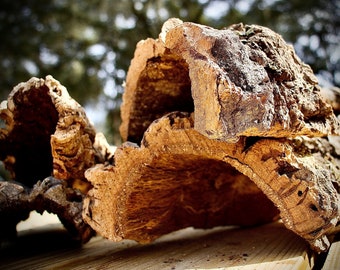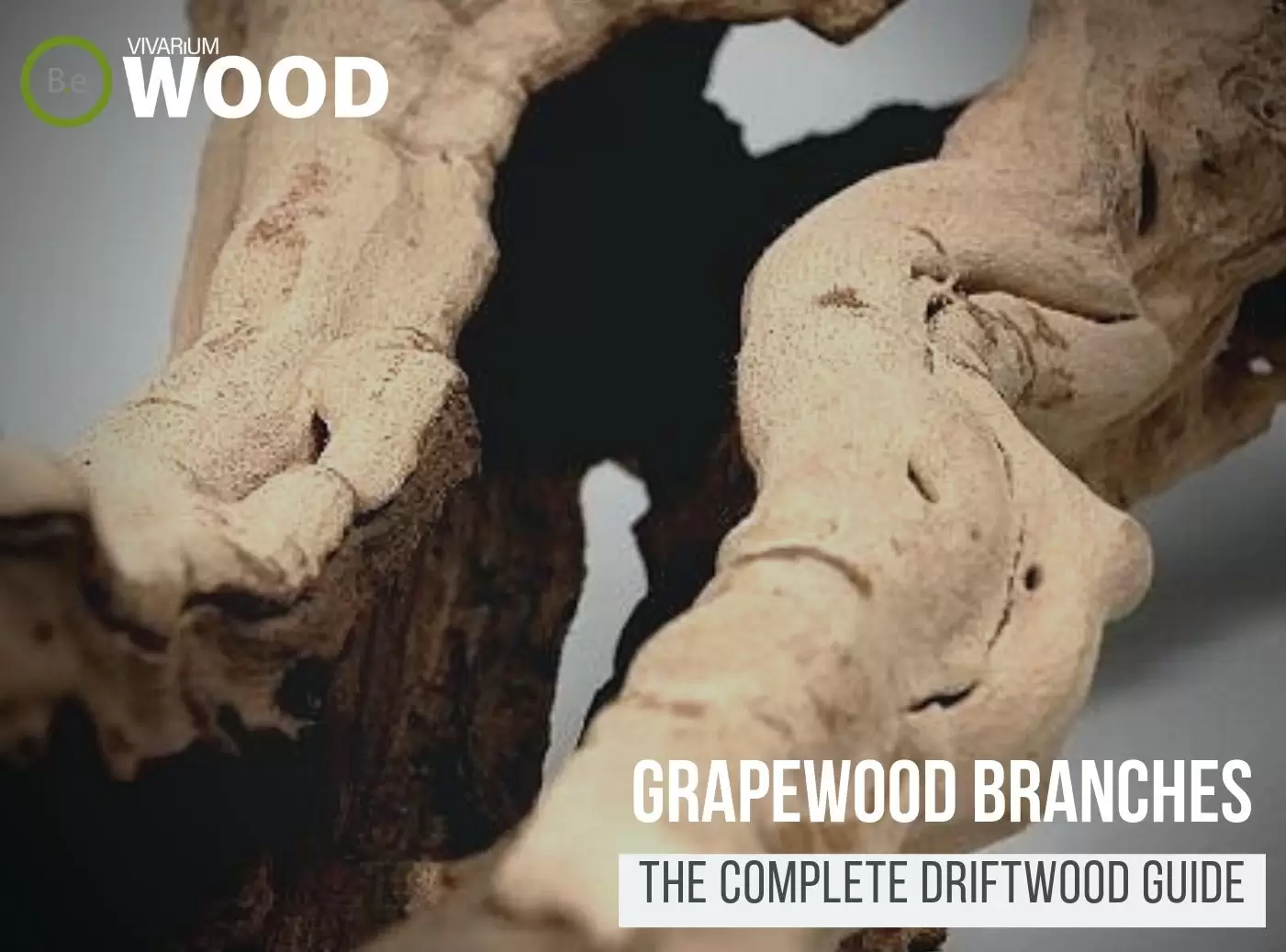If you are looking for a hardscape wood that is eco-friendly, virtually waterproof, and extremely buoyant, you should consider Cork Bark.
This wood is very unique from other driftwood and is widely utilized within the vivarium niche.
Many hobbyists might already be familiar with its use in dry enclosures like terrariums but Cork can also be found to have a benefit in aquariums as well.
This article will provide an in-depth understanding of the unique tree bark and how to properly manage it in a number of biotypes.
| Quick Stats: | |
|---|---|
| Scientific Name | Quercus Suber |
| Botanical Name | Cork Bark |
| Other Common Names | Cork Oak Bark, Cork Bark Rounds, Cork Bark Flats, Cork Bark Hides |
| Origin (Habitat) | Southwest Europe, Northwest Africa(Forest) |
| Height | Up to 12 in |
| Color | Dark Gray |
| PH Impact | Acidic |
| Plant Type (Sector) | Tree (Bark) |
What Is Cork Bark?
Cork Bark is the outer layer of a cork oak tree that is peeled off during harvesting.
Scientifically known as Quercus Suber, these trees have the unique ability to regrow their bark once the perennial plant has reached the adult age of approximately 25 years old.
Quercus Suber is the only species of tree that can fully regrow bark as thick and insulated as cork.


Cork Bark Facts
Cork is impermeable and buoyant making it ideal for a number of uses in multiple industries.
It has been the primary source for containing liquids like wine since the Ancient Greek era.
Cork Oak trees are evergreen plants that don’t drop their leaves between seasons.
This makes the type of wood considered to be softwood and one of the few that is rot-resistant.
Cork Bark is thought to be the best wood for terrariums because of these factors.
Many enthusiasts will use it to create realistic backgrounds to add depth and offer additional areas to mount epiphytes on.
Description
Quercus Suber produces bark that is relatively easy to recognize.
All Cork Bark will generally consist of the same characteristics and will look similar to one another with the exception of size and patterns.
Depending on how long the bark was able to mature before harvesting, the thickness will range between one to three inches.
This bark is typically sold in lengths under 12 inches.
A rugged dark gray surface can be found on the outer layer of Cork Bark.
The inner side of the bark is a bright orange color and will typically have a surface that’s smooth to the touch.
Cork sold for vivarium use can come in a number of varieties depending on your preference.
The wood will either be a whole hide, partially round or flattened pieces that are cut from larger hides during harvest.
The density of Cork Bark is another notable feature that sets this wood apart from others.
It is one of the lightest woods used in the vivarium hobby.
The extremely light, buoyant wood is excellent for use in high quantities and can be mounted or stacked high with a low risk of collapse and damage to the tank or inhabitants.
Habitat
Quercus Suber is indigenous to the forest of Southwest Europe and Northwest Africa.
Portugal is known to be the biggest exporter of Cork in the world.
The climate of these areas is typically dry, hot, and prone to wildfires.
Cork Oak trees use their thick bark as natural insulation protecting them from the extreme conditions of wildfires.
The regenerate factor of the bark allows the trees to easily repair any damage it would consume during these events.
Environmental Influence
When placed in or around water, Cork Bark can have a long influence on water parameters.
Like most other driftwood, this bark will moderately lower PH and water hardness.
This can be beneficial for freshwater biotypes that require water conditions to be soft.
Furthermore, Cork can also act as a suitable substrate above land for plants to latch on to when soil isn’t required.
Vivarium Type
Cork Bark is most often used as background pieces for terrariums with little to no aquatic features.
Believe it or not, Cork is also frequently used as driftwood in aquariums and other types of vivariums with aquatic features.
This versatile wood will provide a healthy source of food to invertebrates as it breaks down and leech into the water.
Use this wood risk-free in any type of vivarium that doesn’t require water hardness to be above 7.
Here is a recommended list of vivariums this bark are commonly used:
- Paludariums – Half aquatic/ half terrain-based enclosure.
- Ripariums – Mostly aquatic-based enclosures with some terrain features present.
- Terrariums – Fully terrain-based enclosures with little to no aquatic features.
- Aquariums – Fully aquatic-based enclosure with no terrain features.
Vivarium Usage
Core Bark can be used in a number of ways within a vivarium.
This type of driftwood is commonly used as both a hardscape as well as a substrate for many vivarium plants, biofilm, and algae.
They last longer above water and are in most cases presoaked to remove excessive tannin.
In aquariums or ripariums, this wood can be used for a number of years due to its being rot-resistant.
Cork will remain buoyant and never sink making it great for floating cover.
If your intentions are to actually fully submerge the wood then you will have to mount it to a heavier source of the material.
In terrariums and the land portions of a paludarium, Cork Bark can be used in a number of ways.
As mentioned earlier, Cork flats make an excellent material to use as a background.
Plants and other hardscapes can easily latch onto the surface.
Cork rounds are great hardscape material to make into caves that inhabitants will hide under or climb above.
Advantages
Cork Bark is an easily accessible wood for all-level hobbyists as it doesn’t present the potential dangers other woods typically do.
The natural look will add detail to any enclosure it is placed in and will hold up for the life of the enclosure as Cork is rot-resistant.
The moderate levels of tannin released are beneficial for softwater setups and often ideal for freshwater tanks.
This type of hardscape wood will provide a place for inhabitants to hide, breed, and eat.
Cork Bark is non-toxic, making it safe for all kinds of inhabitants.
Disadvantages
One of the biggest drawbacks of using Cork Bark in aquariums is the fact that it will always float.
If you’re intent is to use it as a floating wood then you will have no problem.
On the other hand, if you want to use it underwater you will have to mount it to another object permanently.
Due to the low water parameter influence, this wood would not be ideal for hard water enclosures that require the PH to be above 7.
The wood does float when it’s dry so that may require periods of pre-soaking or anchoring.
Buy Cork Bark
When looking into Cork Bark for sale, expect a few key indicators you are buying the best quality wood.
These woods should always be free of pests.
In addition, the source of driftwood should come from a contributor who Preferably specializes in the pet industry.
Decide on whether it will be flats, rounds, or entire hides you will need for a project before ordering the bark.
Click the image below to find out more about the current price and other relative info:


Cork Bark Preparation
When acquiring Cork Bark for the first time, it may need to be properly conditioned before going into a vivarium.
All pieces should be inspected to make certain no pest or rot has taken residence within the wood.
Once checked, it can be cleaned and placed securely within the desired enclosure.
Sterilizing Cork Bark
Above all, It is always a good idea to sterilize driftwood when you first receive it.
A light brushing will knock excess dirt and sand off.
Be careful not to damage the surface of the bark with a strong force of water when cleaning.
In addition, if the pieces of wood are small enough to fit in a pot, boiling the wood is a definite way to kill bacteria as well as saturate the wood from tannins that will lead to unwanted water coloration.
Sinking Cork Bark
Cork Bark can be extremely difficult to sink in an aquarium.
There are usually two reasons for wanting to place bark underwater.
That is more likely to either use as an aquatic background or as a centerpiece in an aquascape.
Using the wood as part of an aquatic background will require mounting directly to the enclosure wall with silicone or screwing it into a larger dense material.
If you opt to use this bark as part of a hardscape, screw it to heavier rocks or mount it directly to the bottom of the enclosure.
Wood Similar To Cork Bark
Adding diversity to an enclosure is key to an aesthetically pleasing enclosure.
Try mixing up the look of your vivarium with different woods that can easily co-exist in the same types of environment.
Furthermore, if for some reason you find this wood hard to acquire or would like to consider something similar to it…
Here are some other kinds of driftwood you might find may do well with or in place of Cork Bark:
Conclusion
In conclusion, Cork Bark is one of the most popular types of vivarium wood in terrariums.
On the contrary, it can also find a place within aquariums if used correctly.
The natural look, resistance to rot, and non-toxicity are all good reasons to consider this bark in a building that houses animals.
If you have any experience working with Cork Bark, feel free to let us know your thoughts about its use and what type of enclosure it was used in down below!
Frequently Asked Questions
Cork bark is primarily used as an aesthetically pleasing decoration for terrariums and reptile habitats. It serves as a safe, attractive, and low-maintenance background that helps to provide great visuals for reptiles and amphibians. Cork bark can also be used as a natural mounted substrate for arboreal species of reptiles and amphibians.
You can find cork bark in nature in Mediterranean climates, such as Spain, Portugal and Northern Africa. Cork bark is typically found on cork oak trees and is used for several purposes, including insulation and wine bottle corks.
Yes, cork bark is a natural product that is harvested from the bark of the cork oak tree. The bark is stripped from the tree and then processed to create a variety of products, including floor and wall tiles, insulation, and bottle stoppers.
No, cork bark does not mold easily. Cork bark is a type of tree bark used in crafts and gardening that typically has a high resistance to rot, bacteria, and fungi. It can easily last for a few years without mold formation.
Yes, cork bark, which is the only outer layer of the cork oak tree, can rot when exposed to water for a prolonged period of time. It is usually used as a lining material in garden pots and containers but can be a short–term alternative for erosion control and landscape edging as it is much less brittle than concrete edging and has slightly better water and erosion resistance.
Cork bark can last anywhere from 5–20 years in outdoor garden settings, depending on the climate and the quality and care given to the bark. Indoors, cork bark can last for several decades when properly maintained.
Yes, plants can grow on cork bark! With proper care, plants such as succulents, bromeliads, and sedums can all be rooted in cork bark and thrive. Cork bark absorbs moisture, making it an ideal planting medium for moisture–loving plants. Additionally, cork bark retains its shape and texture for extended periods of time.



